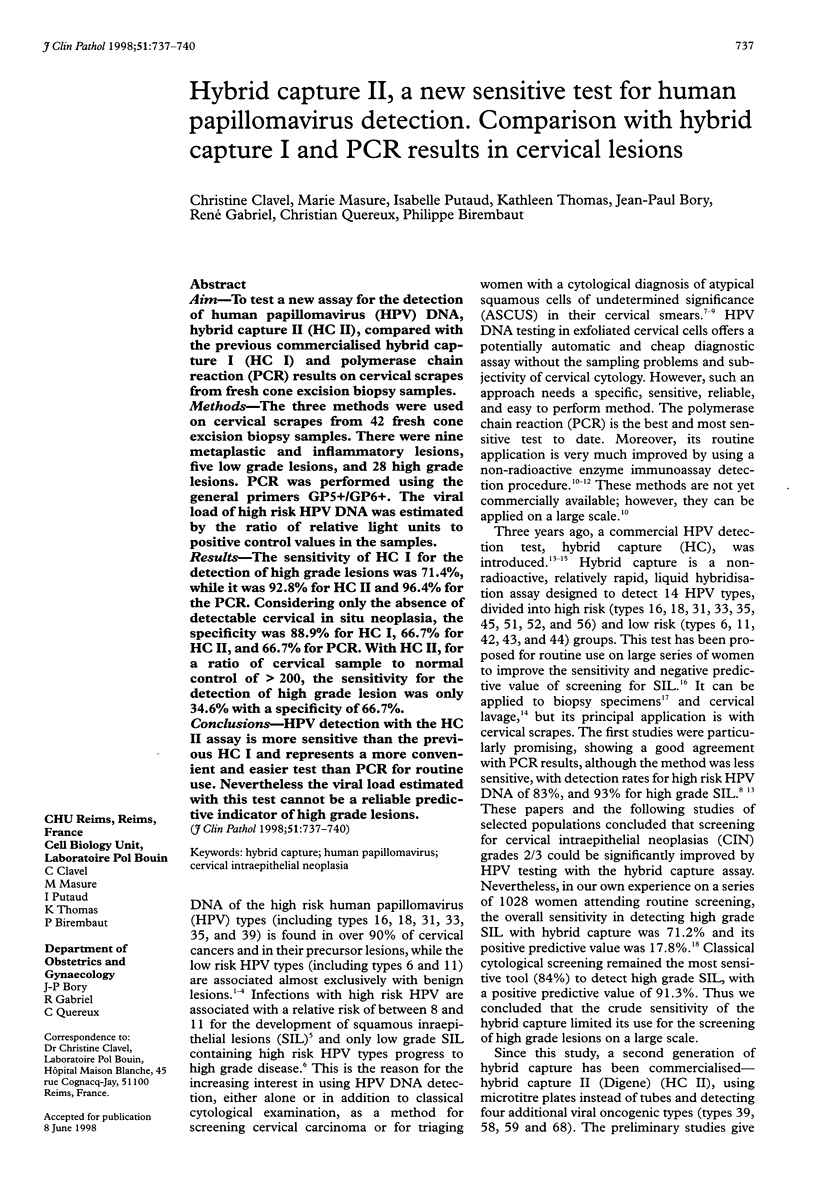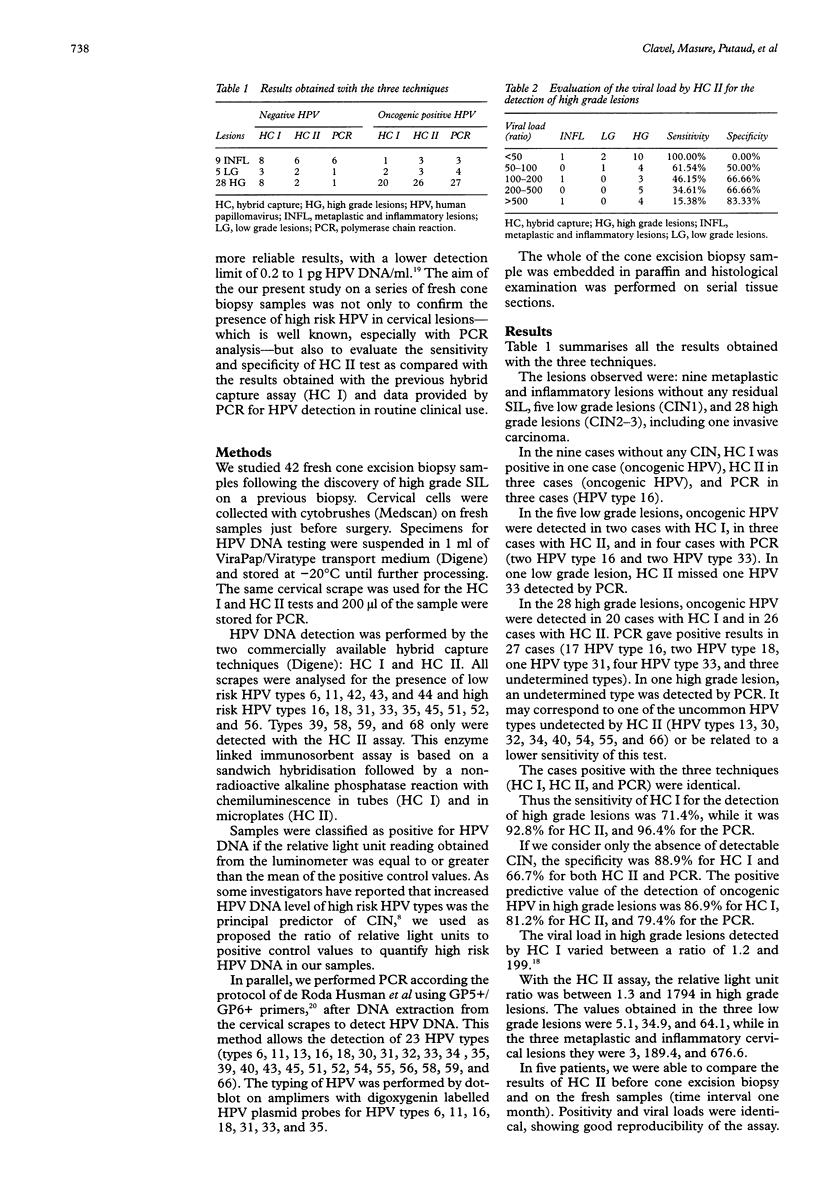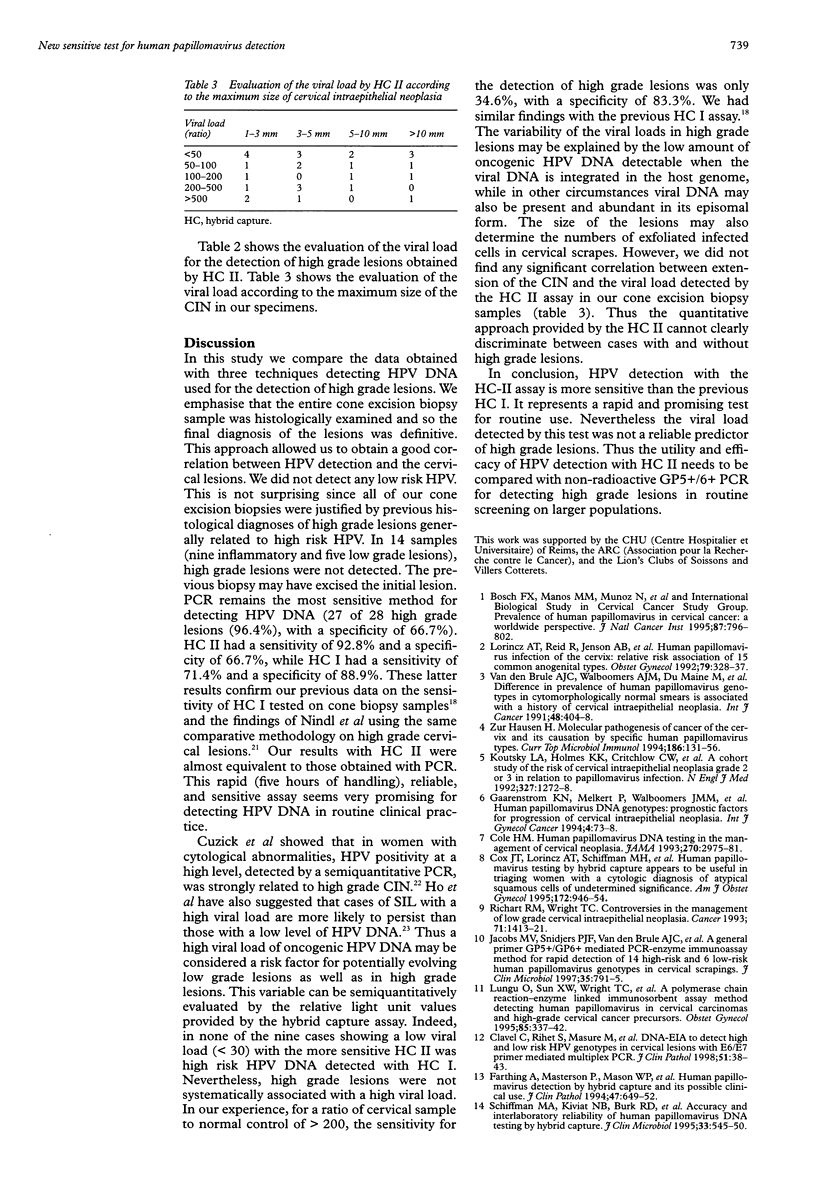Abstract
AIM: To test a new assay for the detection of human papillomavirus (HPV) DNA, hybrid capture II (HC II), compared with the previous commercialized hybrid capture I (HC I) and polymerase chain reaction (PCR) results on cervical scrapes from fresh cone excision biopsy samples. METHODS: The three methods were used on cervical scrapes from 42 fresh cone excision biopsy samples. There were nine metaplastic and inflammatory lesions, five low grade lesions, and 28 high grade lesions. PCR was performed using the general primers GP5+/GP6+. The viral load of high risk HPV DNA was estimated by the ratio of relative light units to positive control values in the samples. RESULTS: The sensitivity of HC I for the detection of high grade lesions was 71.4%, while it was 92.8% for HC II and 96.4% for the PCR. Considering only the absence of detectable cervical in situ neoplasia, the specificity was 88.9% for HC I, 66.7% for HC II, and 66.7% for PCR. With HC II, for a ratio of cervical sample to normal control of > 200, the sensitivity for the detection of high grade lesion was only 34.6% with a specificity of 66.7%. CONCLUSIONS: HPV detection with the HC II assay is more sensitive than the previous HC I and represents a more convenient and easier test than PCR for routine use. Nevertheless the viral load estimated with this test cannot be a reliable predictive indicator of high grade lesions.
Full text
PDF



Selected References
These references are in PubMed. This may not be the complete list of references from this article.
- Bosch F. X., Manos M. M., Muñoz N., Sherman M., Jansen A. M., Peto J., Schiffman M. H., Moreno V., Kurman R., Shah K. V. Prevalence of human papillomavirus in cervical cancer: a worldwide perspective. International biological study on cervical cancer (IBSCC) Study Group. J Natl Cancer Inst. 1995 Jun 7;87(11):796–802. doi: 10.1093/jnci/87.11.796. [DOI] [PubMed] [Google Scholar]
- Brown D. R., Rawlings K., Handy V., Fife K. H., Bryan J. T., Cramer H., Graham M. Human papillomavirus detection by hybrid capture in paired cervicovaginal lavage and cervical biopsy specimens. J Med Virol. 1996 Feb;48(2):210–214. doi: 10.1002/(SICI)1096-9071(199602)48:2<210::AID-JMV15>3.0.CO;2-I. [DOI] [PubMed] [Google Scholar]
- Clavel C., Bory J. P., Rihet S., Masure M., Duval-Binninger I., Putaud I., Lorenzato M., Quereux C., Birembaut P. Comparative analysis of human papillomavirus detection by hybrid capture assay and routine cytologic screening to detect high-grade cervical lesions. Int J Cancer. 1998 Feb 9;75(4):525–528. doi: 10.1002/(sici)1097-0215(19980209)75:4<525::aid-ijc6>3.0.co;2-v. [DOI] [PubMed] [Google Scholar]
- Clavel C., Rihet S., Masure M., Chypre C., Boulanger J. C., Quereux C., Birembaut P. DNA-EIA to detect high and low risk HPV genotypes in cervical lesions with E6/E7 primer mediated multiplex PCR. J Clin Pathol. 1998 Jan;51(1):38–43. doi: 10.1136/jcp.51.1.38. [DOI] [PMC free article] [PubMed] [Google Scholar]
- Cox J. T., Lorincz A. T., Schiffman M. H., Sherman M. E., Cullen A., Kurman R. J. Human papillomavirus testing by hybrid capture appears to be useful in triaging women with a cytologic diagnosis of atypical squamous cells of undetermined significance. Am J Obstet Gynecol. 1995 Mar;172(3):946–954. doi: 10.1016/0002-9378(95)90026-8. [DOI] [PubMed] [Google Scholar]
- Cuzick J., Terry G., Ho L., Hollingworth T., Anderson M. Type-specific human papillomavirus DNA in abnormal smears as a predictor of high-grade cervical intraepithelial neoplasia. Br J Cancer. 1994 Jan;69(1):167–171. doi: 10.1038/bjc.1994.28. [DOI] [PMC free article] [PubMed] [Google Scholar]
- Diagnostic and therapeutic technology assessment. Human papillomavirus DNA testing in the management of cervical neoplasia. JAMA. 1993 Dec 22;270(24):2975–2981. [PubMed] [Google Scholar]
- Farthing A., Masterson P., Mason W. P., Vousden K. H. Human papillomavirus detection by hybrid capture and its possible clinical use. J Clin Pathol. 1994 Jul;47(7):649–652. doi: 10.1136/jcp.47.7.649. [DOI] [PMC free article] [PubMed] [Google Scholar]
- Gaarenstroom K.N., Melkert P., Walboomers J.M.M., Van Den Brule A.J.C., Van Bommel P.F.J., Meyer C.J.L.M., Voorhorst F.J., Kenemans P., Helmerhorst Th.J.M. Human papillomavirus DNA and genotypes: prognostic factors for progression of cervical intraepithelial neoplasia. Int J Gynecol Cancer. 1994 Mar;4(2):73–78. doi: 10.1046/j.1525-1438.1994.04020073.x. [DOI] [PubMed] [Google Scholar]
- Hatch K. D., Schneider A., Abdel-Nour M. W. An evaluation of human papillomavirus testing for intermediate- and high-risk types as triage before colposcopy. Am J Obstet Gynecol. 1995 Apr;172(4 Pt 1):1150–1157. doi: 10.1016/0002-9378(95)91473-0. [DOI] [PubMed] [Google Scholar]
- Ho G. Y., Burk R. D., Klein S., Kadish A. S., Chang C. J., Palan P., Basu J., Tachezy R., Lewis R., Romney S. Persistent genital human papillomavirus infection as a risk factor for persistent cervical dysplasia. J Natl Cancer Inst. 1995 Sep 20;87(18):1365–1371. doi: 10.1093/jnci/87.18.1365. [DOI] [PubMed] [Google Scholar]
- Jacobs M. V., Snijders P. J., van den Brule A. J., Helmerhorst T. J., Meijer C. J., Walboomers J. M. A general primer GP5+/GP6(+)-mediated PCR-enzyme immunoassay method for rapid detection of 14 high-risk and 6 low-risk human papillomavirus genotypes in cervical scrapings. J Clin Microbiol. 1997 Mar;35(3):791–795. doi: 10.1128/jcm.35.3.791-795.1997. [DOI] [PMC free article] [PubMed] [Google Scholar]
- Koutsky L. A., Holmes K. K., Critchlow C. W., Stevens C. E., Paavonen J., Beckmann A. M., DeRouen T. A., Galloway D. A., Vernon D., Kiviat N. B. A cohort study of the risk of cervical intraepithelial neoplasia grade 2 or 3 in relation to papillomavirus infection. N Engl J Med. 1992 Oct 29;327(18):1272–1278. doi: 10.1056/NEJM199210293271804. [DOI] [PubMed] [Google Scholar]
- Lorincz A. T., Reid R., Jenson A. B., Greenberg M. D., Lancaster W., Kurman R. J. Human papillomavirus infection of the cervix: relative risk associations of 15 common anogenital types. Obstet Gynecol. 1992 Mar;79(3):328–337. doi: 10.1097/00006250-199203000-00002. [DOI] [PubMed] [Google Scholar]
- Lungu O., Sun X. W., Wright T. C., Jr, Ferenczy A., Richart R. M., Silverstein S. A polymerase chain reaction-enzyme-linked immunosorbent assay method for detecting human papillomavirus in cervical carcinomas and high-grade cervical cancer precursors. Obstet Gynecol. 1995 Mar;85(3):337–342. doi: 10.1016/0029-7844(94)00399-x. [DOI] [PubMed] [Google Scholar]
- Nindl I., Zahm D. M., Meijer C. J., Walboomers J. M., Schneider A. Human papillomavirus detection in high-grade squamous intraepithelial lesions. Comparison of hybrid capture assay with a polymerase chain reaction system. Diagn Microbiol Infect Dis. 1995 Dec;23(4):161–164. doi: 10.1016/0732-8893(95)00187-5. [DOI] [PubMed] [Google Scholar]
- Richart R. M., Wright T. C., Jr Controversies in the management of low-grade cervical intraepithelial neoplasia. Cancer. 1993 Feb 15;71(4 Suppl):1413–1421. doi: 10.1002/cncr.2820710406. [DOI] [PubMed] [Google Scholar]
- Schiffman M. H., Kiviat N. B., Burk R. D., Shah K. V., Daniel R. W., Lewis R., Kuypers J., Manos M. M., Scott D. R., Sherman M. E. Accuracy and interlaboratory reliability of human papillomavirus DNA testing by hybrid capture. J Clin Microbiol. 1995 Mar;33(3):545–550. doi: 10.1128/jcm.33.3.545-550.1995. [DOI] [PMC free article] [PubMed] [Google Scholar]
- Sun X. W., Ferenczy A., Johnson D., Koulos J. P., Lungu O., Richart R. M., Wright T. C., Jr Evaluation of the Hybrid Capture human papillomavirus deoxyribonucleic acid detection test. Am J Obstet Gynecol. 1995 Nov;173(5):1432–1437. doi: 10.1016/0002-9378(95)90629-0. [DOI] [PubMed] [Google Scholar]
- de Roda Husman A. M., Walboomers J. M., van den Brule A. J., Meijer C. J., Snijders P. J. The use of general primers GP5 and GP6 elongated at their 3' ends with adjacent highly conserved sequences improves human papillomavirus detection by PCR. J Gen Virol. 1995 Apr;76(Pt 4):1057–1062. doi: 10.1099/0022-1317-76-4-1057. [DOI] [PubMed] [Google Scholar]
- zur Hausen H. Molecular pathogenesis of cancer of the cervix and its causation by specific human papillomavirus types. Curr Top Microbiol Immunol. 1994;186:131–156. doi: 10.1007/978-3-642-78487-3_8. [DOI] [PubMed] [Google Scholar]


